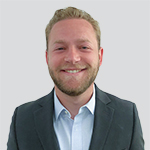CMS is preparing to propose mandatory minimum staffing requirements for skilled nursing facilities (SNFs) — but a KFF analysis suggests that most facilities won't be able to meet the mark. A mandatory staffing mandate could spell trouble for the SNF industry, and Advisory Board's Blake Zissman is here to explain why.
Background
While insufficient staffing has been a longstanding concern for SNFs, high mortality rates during the COVID-19 pandemic underscored the consequences of inadequate staffing levels. In February 2022, the Biden administration announced plans to set new minimum requirements for SNF staffing levels.
Typically, staffing levels and requirements are specified as direct care hours per resident day (HPRD), which is calculated using the total number of hours worked by each type of nursing staff divided by the total number of residents in a facility.
A 2001 CMS report recommended a nationwide ratio of 4.1 HPRD — but this ratio has never been made into law.
In April, the Biden administration issued an executive order directing the secretary of HHS to promote sufficient staffing levels and reduce turnover at SNFs. Now, CMS is on the verge of proposing new mandatory staffing levels — a move that could improve care quality but may cost the industry billions of dollars.
How many SNFs would meet new staffing requirements?
To evaluate how many facilities would meet HPRD requirements, KFF analyzed data collected from 14,575 nursing facilities in June.
According to the analysis, nearly all nursing facilities meet the current staffing requirements of 0.3 HPRD, and most would meet requirements of 3.0 HPRD or below.
Most facilities would meet requirements of 2.5 HPRD or below, and 85% would meet requirements of 3.0 HPRD. However, if CMS proposes new minimum requirements of 4.0 HPRD or higher, most facilities will need to hire additional staff to comply. Nationwide, just 29% of facilities would be compliant with 4.0 HPRD requirements.
Ultimately, KFF's findings are concerning — but not surprising.
An analysis published by CliftonLarsonAllen in December 2022 found that only 6% of all SNFs could meet a mandate of 4.1 HPRD and only 27% could meet a mandate of 3.1 HPRD. The improved figures in KFF's analysis are likely due to the general staffing recovery happening across the healthcare continuum.
Why a new staffing mandate could spell trouble for SNFs
While the new requirements are still unknown, industry stakeholders have mixed views on the impending staffing mandate.
Earlier this month, the American Health Care Association, which represents for-profit and nonprofit facilities, told the Biden administration that a requirement would "worsen access to care."
Meanwhile, long-term care advocates and unions that represent nursing home staff are urging the administration to take steps to reform the SNF industry.
However, the SNF industry will be in trouble if a higher mandate is approved. Without additional funding or another source of new revenue, many SNFs will be unable to address longstanding financial issues that have constrained staffing growth since before the onset of COVID-19.
And although there have been improvements to employment levels at SNFs, the current pipeline of staff is not sufficient to meet higher proposed HPRD mandates. Even if 85% of SNFs can meet a potential 3.0 HPRD threshold, a large number of SNFs will still be at risk — and will put patients at risk as well.
Realistically, we expect CMS to propose a staffing minimum that is less than 3.1 HPRD in an attempt to avoid major industry shortages.
CMS is expected to issue a proposed rule sometime this year, but the agency has been relatively silent on their progress towards an official final mandate announcement.
In the meantime, SNFs need to do all they can to best position themselves for any level of staffing mandate by focusing on recruiting and retaining talent. To learn more about what your organization can do to prepare right now, read our expert insight. (Chidambaram et al., KFF, 7/14; Dreher, Axios, 7/18)
CMS is on the verge of proposing new mandatory staffing levels at SNFs, a move that could improve care quality but may cost the industry billions of dollars. Learn about three ways the mandate could unfold — and how to prepare for what comes next.
Don't miss out on the latest Advisory Board insights
Create your free account to access 1 resource, including the latest research and webinars.
Want access without creating an account?
You have 1 free members-only resource remaining this month.
1 free members-only resources remaining
1 free members-only resources remaining
You've reached your limit of free insights
Become a member to access all of Advisory Board's resources, events, and experts
Never miss out on the latest innovative health care content tailored to you.
Benefits include:
You've reached your limit of free insights
Become a member to access all of Advisory Board's resources, events, and experts
Never miss out on the latest innovative health care content tailored to you.
Benefits include:
This content is available through your Curated Research partnership with Advisory Board. Click on ‘view this resource’ to read the full piece
Email ask@advisory.com to learn more
Click on ‘Become a Member’ to learn about the benefits of a Full-Access partnership with Advisory Board
Never miss out on the latest innovative health care content tailored to you.
Benefits Include:
This is for members only. Learn more.
Click on ‘Become a Member’ to learn about the benefits of a Full-Access partnership with Advisory Board
Never miss out on the latest innovative health care content tailored to you.

